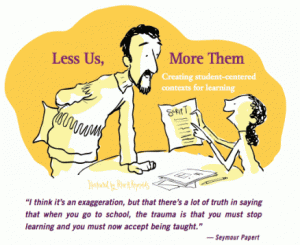With the development of science and technology and the progress of the times, there are many kinds of ways the learner can learn the knowledge and gain the information. In week 3’s post, I will show the differences between Instructor-centered learning and student-centered learning, Asynchronous and synchronous learning and Connectivism.
Instructor-centered Versus Student-centered Learning

Firstly, Instructor-centered learning and student-centered learning are two ways to learn. According to the article I read, I knew when we know which direction the course will take firstly, we can know which type of learning is most suitable for the course. In terms of Instructor-centered learning, students are dependent on the teacher. Because the teacher’s knowledge is authoritative for students and they are the people who can solve all the problems in the course. But this kind of learning is not effective for the large classes. (MOOCs) The instructors usually don’t have enough time to spend on everyone in the courses and they should know how to answer the students’ questions most effectively and practically. So the article suggests the students use self-directed learning. Student-centered learning can help a student think independently and manage their study more efficiently. And they can discover the knowledge from the internet or books by themselves and analyze which information are the main points.
Asynchronous Versus Synchronous Learning
Secondly, Asynchronous courses are the courses do not need the instructors and the learners to meet together at the same time. Such as online courses. I think this kind of learning is suitable for working people who don’t have much time and they can arrange their study time to maximize their flexibility. So everyone can study at different pace and time. Synchronous learning requires the instructors and learners to meet with each other at the same time and same space. Such as the normal classes at the campus are the examples for the synchronous course. I think Synchronous courses are more effective because the students can meet the teacher face to face. And they can receive a quick response when they face the problems. Moreover, the study environment will make people feel like immersive learning and learners can ask other classmates about the course material because they are at the same pace. In addition, these two types of courses can mix if this is suitable for the instructors’ course and increase the effectiveness of the course.
Connectivism

Lastly, technology changed our ways of learning and lifestyles. According to “Connectivism: A Learning Theory for the Digital Age”, Siemens states that learning is the process of connecting specialized nodes and information sources. The ability to learn what an individual needs is more important than the ability to master it. And it is very important for learners to distinguish between significant information and insignificant information. As knowledge grows and evolves, access to the required knowledge is more important than what the learner currently has. The faster knowledge develops, the less likely it is that individuals will possess all knowledge. We can focus our learning on connecting the expertise series. This connection enables us to learn more and more important than existing knowledge systems.
Refrences
Connectivism: A Learning Theory for the Digital Age. Siemens, G. (2005). International Journal of Instructional Technology and Distance Learning, 2(1).
Grosslin, M. (2018). Basic Philosophies of Distributed and Open Learning. https://uta.pressbooks.pub/onlinelearning/chapter/chapter-2-basic-philosophies/
Pappas, C. (2019, September 26). Synchronous vs Asynchronous Learning: Can You Tell the Difference? Retrieved from https://elearningindustry.com/synchronous-vs-asynchronous-learning-can-you-tell-the-difference
Kennedy, M. (2015, August 31). Student Centered vs. Teacher Centered Learning. Retrieved from https://medium.com/synapse/student-centered-vs-teacher-centered-learning-2184a7521720
Week 7 – Connectivism – As Easy as Falling Off a Log! (n.d.). Retrieved from http://www.mlmcpherson.com/omde-610-journal/week-7-connectivism-as-easy-as-falling-off-a-log
